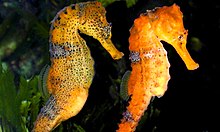The slender seahorse or longsnout seahorse (Hippocampus reidi) is a species of fish in the family Syngnathidae[3] that usually inhabits subtropical regions.
| Slender seahorse | |
|---|---|

| |
| Male and female Hippocampus reidi | |
| Scientific classification | |
| Domain: | Eukaryota |
| Kingdom: | Animalia |
| Phylum: | Chordata |
| Class: | Actinopterygii |
| Order: | Syngnathiformes |
| Family: | Syngnathidae |
| Genus: | Hippocampus |
| Species: | H. reidi
|
| Binomial name | |
| Hippocampus reidi Ginsburg, 1933
| |
Etymology
editThe specific name honors Earl D. Reid of the Division of Fishes at the Smithsonian Institution.[4]
Description
editThe slender seahorses have a gestation period of around two weeks and typically grow to be approximately 6.8 inches long (17.5 centimeters), while the mean height of juvenile slender seahorses is only around 8.2 millimeters.[5] Males are usually orange, while the females are yellow. However, both males and females may have brown or white spots placed sporadically upon their body. These spots may also change into a pink or white color during the courtship period.[6]
Habitat and distribution
editThe slender seahorse has been found at depths of 55 meters (180 feet). Smaller individuals inhabit shallower waters. The slender seahorse has an affinity for coral reefs[6] and seagrass beds and can be found on gorgonian coral, seagrass, mangroves, and Sargassum. It is native to many countries, including the Bahamas, Barbados, Belize, Bermuda, Brazil, Colombia, Cuba, Grenada, Haiti, Jamaica, Panama, United States (Florida and North Carolina), and Venezuela.[1] It inhabits subtropical regions, ranging from 29 degrees north to 25 degrees south and 133 degrees west to 40 degrees east.[3] The species is common in China and more so in Brazil, but in both areas is at risk of becoming an endangered species. In China these seahorses are used for trade and for traditionally Chinese medication, while in Brazil they are heavily traded, involving the commercial extraction of 25 million seahorses per year.[7]
References
edit- ^ a b Oliveira, T.; Pollom, R. (2017). "Hippocampus reidi". IUCN Red List of Threatened Species. 2017: e.T10082A17025021. doi:10.2305/IUCN.UK.2017-3.RLTS.T10082A17025021.en. Retrieved 14 November 2021.
- ^ "Appendices | CITES". cites.org. Retrieved 2022-01-14.
- ^ a b Froese, R.; Pauly, D. (6 October 2010). "FishBase".
- ^ Isaac Ginsburg (1933). "Descriptions of five new species of seahorses". Journal of the Washington Academy of Sciences. 23 (12): 560–563.
- ^ Hora, Maik (16 Mar 2009). "Closing the reproductive cycle: Growth of the seahorse Hippocampus reidi (Teleostei, Syngnathidae) from birth to adulthood under experimental conditions". Aquaculture. 292 (1–2): 39. Bibcode:2009Aquac.292...37H. doi:10.1016/j.aquaculture.2009.03.023.
- ^ a b "Slender seahorse". Monterey Bay Aquarium. Archived from the original on 2012-07-21.
- ^ Cividanes da Hora, Maik dos Santos (July 1, 2009). "Closing the reproductive cycle: Growth of the seahorse Hippocampus reidi (Teleostei, Syngnathidae) from birth to adulthood under experimental conditions". Aquaculture. 292 (1): 37–41. Bibcode:2009Aquac.292...37H. doi:10.1016/j.aquaculture.2009.03.023. Retrieved October 14, 2020.
External links
edit- Photos of Slender seahorse on Sealife Collection
